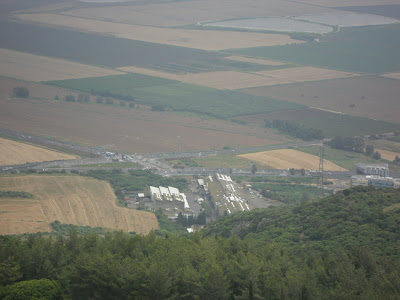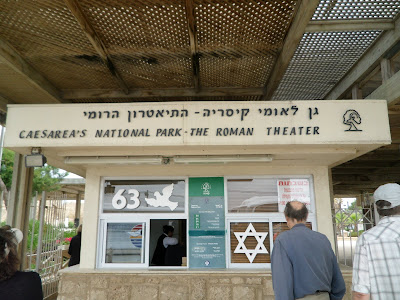
Mount Carmel is best known as the site of Elijah’s confrontation with the prophets of Baal. Located about halfway between Jezebel’s Sidon and Ahab’s Samaria, the site was well chosen for God to display of His superiority over the pagan god. Here, this dramatic demonstration climaxed when God honored Elijah’s challenge to Baal and hurled down fire to burn up his water-soaked sacrifice (1 Kings 18:19-40). This event probably occurred in an amphitheater-like small plain near the base of the mountain, close to the Kishon stream.
The statue at the Carmelite monastery at the top of the mount reflects the Lord's victory over the prophets of Baal.  Carmelite Monastery located on the top of Mount Carmel. They have a roof garden that we were allowed to go up on (after the rain) to take advantage of the views.
Carmelite Monastery located on the top of Mount Carmel. They have a roof garden that we were allowed to go up on (after the rain) to take advantage of the views.
"Your head crowns you like Mount Carmel. Your hair is like royal tapestry; the king is held captive by its tresses." Song of Solomon 7:5
"He rebukes the sea and dries it up; he makes all the rivers run dry. Bashan and Carmel wither and the blossoms of Lebanon fade." Nahum 1:4


 On our way to Caesarea we stopped on the coast of the Mediterranean to get a picture of the Aqueduct that Herod had built to supply water to the old city. It truly was remarkable but there was quite the storm brewing and quite the breeze blowing and I wasn't too sure if I really wanted off the bus!!
On our way to Caesarea we stopped on the coast of the Mediterranean to get a picture of the Aqueduct that Herod had built to supply water to the old city. It truly was remarkable but there was quite the storm brewing and quite the breeze blowing and I wasn't too sure if I really wanted off the bus!! Oh well, how many times are you going to have this opportunity!!
Oh well, how many times are you going to have this opportunity!! The Aqueduct brought running water to the old city of Caesarea. The source of the water was the springs of Shummi, 10KM away. Herod build the aqueduct in the 1st C BC. later, in the 2nd C AD it was expanded by the Romans. Later, 2 more aqueducts were built.
The Aqueduct brought running water to the old city of Caesarea. The source of the water was the springs of Shummi, 10KM away. Herod build the aqueduct in the 1st C BC. later, in the 2nd C AD it was expanded by the Romans. Later, 2 more aqueducts were built. Caesarea was located on the Mediterranean coast thirty-three miles north of Joppa and sixty miles northwest of Jerusalem.
Caesarea was located on the Mediterranean coast thirty-three miles north of Joppa and sixty miles northwest of Jerusalem. Herod built his seaport on the site of the old Phoenician city, Strato’s Tower. The place was given this name after the king of Sidon, Strato I, erected a tower as a lighthouse and built a small, fortified port to provide anchorage for ships sailing in the eastern Mediterranean. No natural ports existed along Israel’s coast. During bad weather, this could be a dangerous sector on the major shipping route from Alexandria to Phoenicia, Syria, and eventually to Athens and Rome. To provide a safe haven, Herod created an artificial harbor, constructing large breakwaters.
Herod built his seaport on the site of the old Phoenician city, Strato’s Tower. The place was given this name after the king of Sidon, Strato I, erected a tower as a lighthouse and built a small, fortified port to provide anchorage for ships sailing in the eastern Mediterranean. No natural ports existed along Israel’s coast. During bad weather, this could be a dangerous sector on the major shipping route from Alexandria to Phoenicia, Syria, and eventually to Athens and Rome. To provide a safe haven, Herod created an artificial harbor, constructing large breakwaters.Caesarea’s harbor was as large as that of Piraeus, Athens’ port. It brought status and revenue to Herod’s kingdom. He used the port to import materials for his numerous building projects. The harbor also made Palestine easily accessible to Rome, only a ten-day voyage away.
 This is a picture of the back of the amphitheater where Kay will be teaching. This view is a little deceiving as you will see below.
This is a picture of the back of the amphitheater where Kay will be teaching. This view is a little deceiving as you will see below. Roman statuary recovered at the site.
Roman statuary recovered at the site.
 Near the amphitheater, a stone tablet was found with an inscription of the name Pontius Pilate, and dedicated to Tiberius Caesar who nominated him as procurator. This tablet probably tells that Pilate consecrated a temple of Tiberius in Caesarea.
Near the amphitheater, a stone tablet was found with an inscription of the name Pontius Pilate, and dedicated to Tiberius Caesar who nominated him as procurator. This tablet probably tells that Pilate consecrated a temple of Tiberius in Caesarea.The tablet says: "Tiberieum, Pontius Pilatus, Prefect of Judea".
(1) TIBERIEUM,,
(2) (PON) TIUS PILATUS
(3) (PRAEF) ECTUS IUDA (EAE)
This is important evidence of the existence of Pontius in Caesarea.

 The square area cut out of the stone above was the fresh water swimming pool in Herod the Great's Palace here in Caesarea.
The square area cut out of the stone above was the fresh water swimming pool in Herod the Great's Palace here in Caesarea.  This is an artist's rendering of the harbor that Herod the Great built at Caesarea.
This is an artist's rendering of the harbor that Herod the Great built at Caesarea. I have included this aerial photo to give an idea of the scope of what was built! After examining the remains of Herod's palace we were driven by bus beyond the stadium and to the Crusader City
I have included this aerial photo to give an idea of the scope of what was built! After examining the remains of Herod's palace we were driven by bus beyond the stadium and to the Crusader City You enter the Crusader City by crossing a bridge over a deep moat and through the gatehouse with beautiful Gothic vaulting!
You enter the Crusader City by crossing a bridge over a deep moat and through the gatehouse with beautiful Gothic vaulting! Kay is waiting for our group to get caught up so she can point out a few things to us...
Kay is waiting for our group to get caught up so she can point out a few things to us... such as the rounding of the edges of these stones which were supposedly made as horses rubbed against them as they made the sharp turn through the gatehouse.
such as the rounding of the edges of these stones which were supposedly made as horses rubbed against them as they made the sharp turn through the gatehouse. The Gothic vaulting of the ceiling!!
The Gothic vaulting of the ceiling!! I think we were all impressed by the gatehouse!
I think we were all impressed by the gatehouse! We had a delicious lunch at the Aresto Restaurant. We had taboon-oven pizza and salad! A taboon oven is a clay oven, shaped like a truncated cone, with an opening at the bottom from which to stoke the fire.
We had a delicious lunch at the Aresto Restaurant. We had taboon-oven pizza and salad! A taboon oven is a clay oven, shaped like a truncated cone, with an opening at the bottom from which to stoke the fire.
 Playing with the camera outside the walls of the Crusader City.
Playing with the camera outside the walls of the Crusader City. Palm Tree growing out of the walls of the Crusader City. Note the size of the moat surrounding the city!!
Palm Tree growing out of the walls of the Crusader City. Note the size of the moat surrounding the city!! The Roman Theater, capable of seating 5,000 spectators, was constructed in the time of Jesus and Pontius Pilate, and has been restored. This is where Kay taught us and where they were setting up for an upcoming concert!
The Roman Theater, capable of seating 5,000 spectators, was constructed in the time of Jesus and Pontius Pilate, and has been restored. This is where Kay taught us and where they were setting up for an upcoming concert!Biblical History
When you are in the Holy Land you quickly realize that wherever you go it it is going to be rich in Biblical history! Here in Caesarea...
After baptizing the Ethiopian eunuch, Philip was "transported" to Azotus (Ashkelon) and from there continued to Caesarea, evangelizing as he traveled (Acts 8:40)
As a result of Paul’s boldly proclaiming Jesus in Jerusalem, the Hellenistic Jews there plotted to put him to death. Believers who were concerned for his life, brought Paul down from Jerusalem to Caesarea to return him to his hometown of Tarsus (Acts 9:28,29).
An angel of the Lord visited Cornelius, a God-fearing Roman centurion at Caesarea, instructing him to send for Peter who was in Joppa (Acts 10:1-8).
Immediately after Peter’s vision of various animals lowered from heaven in a white sheet, messengers arrived, summoning Peter to the centurion’s residence in Caesarea, a two-day journey up the coast. There Peter first preached the gospel to Gentiles. Cornelius and his Gentile household believed in Jesus and received the gift of the Holy Spirit, validating the fact that salvation was for all people (Acts 10:24-48).
Herod Agrippa I died in Caesarea after "being eaten by worms" as God’s judgment on him for receiving praise due only to the Lord (Acts 12:19, 21-23).
The apostle Paul returned from his second and third missionary journeys to the port of Caesarea (Acts 18:22; 21:8). After his third journey, Paul stayed in the city with Philip and his four virgin daughters who were prophetesses. Paul then proceeded to Jerusalem with several disciples from Caesarea (Acts 21:9-16).
Because of danger to his life, the Roman authorities in Jerusalem sent Paul to Caesarea for trial. The apostle gave a bold witness to Christ during his hearings before Felix, Festus, and King Agrippa. Under house arrest for two years at Caesarea, Paul eventually used his Roman citizenship to appeal to Caesar for a hearing (Acts 23:23- 26:32).





No comments:
Post a Comment